Did Joseph Smith truly believe he was a prophet? Historian Don Bradley spent decades exploring this question. In this compelling presentation, Bradley lays out the case that Joseph Smith was a sincere prophet, whose life patterns and spiritual convictions reveal deep authenticity—not opportunism.

August 2023
Introduction by Scott Gordon
Don Bradley is an author and independent historian specializing in the beginnings of the Latter-day Saint restoration; completed an MA in history Utah State University and a BA in history at Brigham Young University; did an internship with the Joseph Smith papers project and was the primary researcher for Brian Hale’s Joseph Smith’s polygamy series. So, with that, I’ll turn the time over to Don Bradley.
Presentation by Don Bradley
Thank you, Scott. So, many of you know me as the author of the book The Lost 116 Pages: Reconstructing the Book of Mormon’s Missing Stories, but many of you may have been wondering in the last little while more about the lost Don Bradley — since I just showed up, I was getting calls, wondering if I was going to be here. But I’m not lost. Or perhaps I should say, ‘I once was lost, but now I’m found.’ These are the wrong glasses, aren’t they? Well, they’ll have to do. I think that’s what Joseph Smith said actually, when he got those interpreters and they were a few inches too wide.
A “Joseph-Smith-ologist”
I am essentially what I would call a “Joseph-Smith-ologist,” to coin a term. Piecing together Joseph Smith’s life, thoughts and motives is arguably the primary thing that I’ve done with my life. Since I began doing archival research in church history while I was still growing up, I’ve now been at this work for over three and a half decades. Well into that work, when I left the church 18 years ago, I intended to write up research as a historian that would demonstrate that Joseph Smith was an opportunist. Somewhere along the line. I changed my mind — In fact, you may have guessed that from my choice of venue today.
I Wanted to Know Joseph Smith’s History
Anyone who knows me well knows that ultimately, my research into Joseph Smith’s history was because I just want to know what happened. I just genuinely want to know what happened. What if we were to play a game of “if.” What’s the craziest thing that you’ve heard people claim about Joseph Smith, or one of the craziest things? Somebody just shout something out. Treasure digging? Well, if that happened (which it did, right?) I would want to know it. How about something that maybe didn’t happen? Or that you think definitely didn’t happen? Horsethief and high on mushrooms? Sure. If Joseph Smith stole horses, I want to know it. If Joseph Smith took mushrooms, I want to know it, right? Whatever it is, I want to know it. If Joseph Smith was visited by aliens in the Sacred Grove, I would want to know it, right? No matter what it is.
Answers are Implicit in the Questions we Ask
From 2005 to 2010, I examined everything I could find that Joseph Smith did and said with one key question in mind. That question was, “What was in it for him?” And since the answers we arrive at are often implicit in the questions we ask, Joseph Smith’s insincerity was a foregone conclusion of that research. But while I was yet a non-believing historian, and then an atheist, I found that the opportunist model I had been using could not account for many of the patterns I observed in Joseph Smith’s behavior. Today, I’ll lay out why — quite apart from any personal act of faith, simply as a historian — I concluded that Joseph Smith was sincerely religious, and truly believed he was a prophet chosen by God.
The Importance of Getting Events in the Right Order
One of the things I’ll say sort of methodologically here to start out with is: much of history is just about getting events in the right order. And this will become really important in some of what we’re going to analyze later. Imagine that we’re trying to do science. And we’re trying to figure out cause-and-effect relationships within nature. But we don’t actually know the order in which the events occur. How well would we be able to figure out what causes what? There’s no way to do it. In order to figure out the cause-and-effect relationships, we have to figure out the order of events in church history, which then can reveal things like motives.
As I lined up the data, I began to change my mind — while I was actually a non-believing historian. As I say, I used to think Joseph Smith was an opportunist. I actually pursued that model quite avidly. I pursued that model for five years. I made myself a specialist in Joseph Smith and money; Joseph Smith and power; Joseph Smith and sex. And along the way, I got hired by Brian Hales, who, for his Joseph Smith’s polygamy series, had me look up most of the 1,500 sources that he ended up citing in his books. did a lot a lot of research on polygamy before the two years I worked for Brian, and a lot since. I would say, pretty arguably, Brian and I are the two people in the world who could lay claim to having the best knowledge of the sources on Joseph Smith and polygamy. So, what is it, then — after all this, what is it that changed my mind? To explain that I’ll need to lay out how a historian thinks and concretely how *this* historian thinks.
How This Historian Thinks: Explanatory Models
First, I think in terms of explanatory models, and I try to assess which model best accounts for the data. I’m perfectly happy to put different models side by side: put them in competition with each other and compare them to see which one most comprehensively explains the data and the events. The best model obviously, is the one that best accounts for the greatest number of historical data points and does so with the greatest simplicity and consistency. A highly accurate model might even enable us to predict what further behaviors we will find a historical figure engaging in. And indeed, my model of Joseph Smith, that I’ll lay out in small measure today, has enabled me in some cases to do just that.
A question some people might have would be, “Can we really know what someone’s motives were?” Consider this. On the way here today driving, you had to make a number of judgments about the intentions of people you don’t even know. And your life depended on the accuracy of those judgments. And here you are. We are designed for social cognition, to be able to understand the thoughts of others. In fact, our whole legal system depends on this idea that we can do just that. To prove a crime, the prosecution will often have to show motive. To show motive, they have to get inside someone’s head, right? Yes, we can do that. We do it all the time. With certain crimes, like manslaughter versus murder, the difference between the crimes is a difference in motive. And so, we make judgments of motive all the time. To do so requires detective work. And so today we’re going to act as detectives looking at Joseph Smith.
Patterns Reveal Motives
How can we know the motives and intentions of others, particularly those in the past? And the answer, I would submit, is patterns. There’s a psychologist named Howard Rachlin, who developed a model in psychology called teleological behaviorism, which for those familiar with behaviorism may sound like a contradiction. But he had this to say in his excellent book, The Science of Self Control.
“The definitive motive of any act lies in its temporal contacts: the pattern of past and future acts, into which the current act fits. It takes time to observe a motive, the more time, the better known the motive can be.”
We can often fool others –and even ourselves — in what we say about our motives, but the long-term patterns of our behavior do not lie. So that observation suggests that we often can’t accurately discern motives from isolated instances of behavior or from limited patterns, but from more extensive behavior patterns; these reveal someone’s true motives. Some might think that only those who directly knew Joseph could actually know, could actually discern, his motives. But I would suggest considering the key reality about those who knew Joseph Smith directly. Everyone who knew Joseph in life always just knew him in a particular limited context or set of contexts — this is a key.
Think about Oliver Cowdery. They shared visions together, they worked through the translation of the Book of Mormon together, they were leaders of the early church together. Emma did not share visions with Joseph. Brigham did not share visions with Joseph — and yet they each knew him very well in certain contexts. Emma obviously knew Joseph’s behavior as a husband and father far better than Oliver did. Brigham knew better Joseph’s behavior in core meetings and so on than Emma would have. There are hundreds of such contexts in Joseph Smith’s life: all the different relationships that he had, all the different circumstances he ended up in. We can think of the analogy of the blind man and the elephant: the people in these different contexts are like the blind man who feels the elephant’s trunk — “the elephant is like a snake.” And one feels the leg — “the elephant is like a tree trunk.”
There’s a difference here between us and people back in the past. They saw Joseph sort of from ‘on the ground,’ you might say: it’s like being in battle, and they could see up close, and they could see the expression on his face. They could see details that wouldn’t be visible from further away. But it takes the aerial view — it takes the view from above — to get the big picture. The historian necessarily sees a historical figure from a greater distance. But precisely because the historian sees from a greater distance, he can see the big picture that the people at the time could not possibly have seen.
One key here is that the larger the pattern of someone’s behaviors, the better we can infer their motives. With Joseph Smith, you can go to the Joseph Smith Papers Documents, main documents page; by my count, there are over 8,200 documents that they list — but then you have to consider how many individual journal entries? So, some of those documents are an entire journal, or an entire minute book. So how many journal entries are there? And in Joseph’s journal, how many entries are there where he’s giving judgments as a justice of the peace, or he’s saying things as a city councilor, so on and so forth? We’ve got thousands of individual entries. And these are just the documents that were in some way created or sort of deputized by Joseph Smith. What about the thousands of documents that were not created by him, but simply were about him from other people in his world?
A Comprehensive Portrait of Joseph Smith’s Character and Motives
A friend of mine actually has put together the most comprehensive chronology so far of the early restoration. And up through Joseph Smith’s death, he has 36,000 entries. Many of those are duplicates, and some of them aren’t directly on Joseph. But that gives you an idea of how much information we have to work with. These sources about Joseph are from people who encountered him across a range of relationships, times, places and circumstances — providing a comprehensive portrait of the man’s character and motives. So, a historian by systematic analysis, can know Joseph Smith — in some ways better than anyone who knew him in life, because they only had a particular angle of vision, but we can take all their angles of vision and put them together.
So why does this particular historian believe Joseph Smith was sincere? Well, the first positive realization I had about Joseph Smith’s character was about how Joseph Smith loved his family. And let me tell you, Joseph Smith loved his family. I’d been working under this model of opportunist, where Joseph was always just doing things for himself. And certain models (I’ll get into those later) of Joseph’s character propose that he was a malignant narcissist or something: this is what one would expect.
Then, I remember thinking, “Can I find an unguarded moment in Joseph’s life, when he can’t possibly be acting, when he’s just going to be acting spontaneously?” And I thought of Carthage jail, where there’s this hail of bullets. His brother is shot, and Joseph cries out something like, “Oh, Hyrum my brother, what have they done to you?” At a moment like that, you can’t play-act, you’re under too much duress. And I started to see more.
Exceptional Events in Joseph’s Childhood
In my graduate work, we looked at a book called Landscape of History by the great cold war historian John Kenneth Galbraith, and Galbraith says, “if you’re trying to write a biography of an exceptional figure in the past, look for exceptional events from their childhood.” If you look for exceptional events in Joseph Smith’s young life — like his leg surgery when he was seven: that was experimental surgery without anesthetic, chipping something like 19 pieces of bone and hacking, hammering, sawing pieces of bone out of his leg. That’s an exceptional event. And some have looked at this to sort of try to psychoanalyze Joseph Smith.
As an ex-Mormon historian, I was curious: how much truth was there in Lucy’s accountant of the surgery? Some people have thought it was overly hagiographical[i]. One of the doctors of the surgery, according to Lucy Mack Smith’s account, asked Joseph if he’d drink some brandy.
“No,” said the child, according to Lucy, “not one drop.” He also refuses wine. And they tell him “Well, you have to have something, or you won’t be able to endure.” And Joseph exclaims, “No… I will not touch one particle of liquor, neither will I be tied down; but I will tell you what I will do. I will have my father sit on the bed and hold me in his arms. And then I will do whatever is necessary in order to have the bone taken out.”
At the time that I was figuring this out, I had a seven-year-old son. And it struck me pretty hard thinking about the nature of innocence: what was going on with this child. And I was really quite struck with the fact that in Lucy’s account, he didn’t just refuse the liquor. He refused the liquor, but he connected refusing the liquor with something else: his father. “I will be alright if my father will hold me.” People are arguing right now that Joseph Smith was sort of a failed father; that he wasn’t a strong father, he failed in that role, and Lucy had to kind of take over and this caused the Smith family to be super dysfunctional, and so on.
Joseph’s Desire to Help His Father
Joseph Smith Senior was a wonderful father. If you read his patriarchal blessings to his children — we are used to the idea that men in the past were crusty, that they had trouble expressing emotion on so on, and it appears that there’s a lot of truth in this culturally — but not this guy. He was as loving and doting a father as he could be. And Lucy says that as he was watching his son die (and that’s what he was watching, Joseph Smith was wasting away) that Joseph Sr. could not come into the room without breaking down in sobs. And so why would Joseph Jr. have connected refusing alcohol with being held by his father?
In Joseph Sr.’s patriarchal blessing to Hyrum, he says to him: “Though he (your father, Joseph senior) has been out of the way with wine, thou hast never forsaken him nor laughed him to scorn.” He’s saying, “Maybe I might have drunk too much sometimes. But unlike Noah’s son Ham, you did not mock me.”
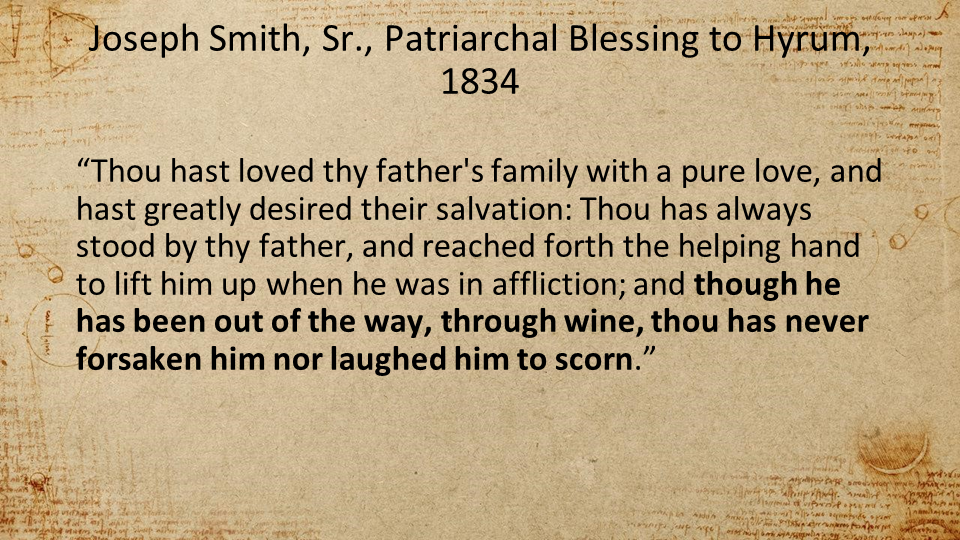
There are other things in Palmyra. We have records of the Smiths buying liquor cider – it is not unusual to drink. This is pre-temperance movement. As someone in the community said, “everyone drank in those days.” Also, they have accounts from as early as Vermont, claiming Joseph Smith Sr. drank too much. He had a problem with alcohol. We have accounts to this effect in Ohio; we have the Patriarchal Blessing to Hyrum; D&C 4 (which, years ago, many of us memorized, though I don’t remember it well enough now), which is addressed to Joseph Sr. where it says something like, “Remember, faith, diligence,” and so on. In the original, earliest manuscripts, it says first, “Remember, temperance,” and then it goes on and it lists other virtues. This revelation through Joseph Jr. to his father again suggests that there is a concern about Joseph Smith (Sr.) and alcohol.
A Noble Child
Now, sometimes Latter-day Saints have found this idea somehow threatening that Joseph Smith Sr. drank alcohol, and he found it addictive. Does this reflect poorly on us? I think it reflects poorly on alcohol, actually. And the Word of Wisdom forbids a number of substances that are addictive. Why does it do this? Because they’re addictive! The idea that someone who was drinking alcohol before the Word of Wisdom, is not something that’s against our faith. It’s more a part of our faith.
So, once you see the connection here, Joseph Jr. is connecting refusal of alcohol to being held by his father. There’s research on children with terminal illnesses that shows that often, those children are very aware that they’re watching their parents watch them die. And they actually try to help their parents through the situation — they try to help their parents. That’s what this child is doing. What I came to see is that he is essentially saying to his dad, “If I can handle this pain, if I can handle this surgery without alcohol, so can you.” This was a noble child.
We have Bill Moran — great guy in the Community of Christ — who has said that Joseph Smith is a malignant narcissist. That was his judgment. Dan Vogel has picked that up also. Dan Vogel is someone I’m friends with, I like him. In quoting these people, I don’t see them as enemies. But I don’t I don’t see that here. This child is an amazing child. And what reflects here is a deep concern for his father. Richard Bushman has said if Joseph Smith had any personal motive in the restoration, it was to save his father.
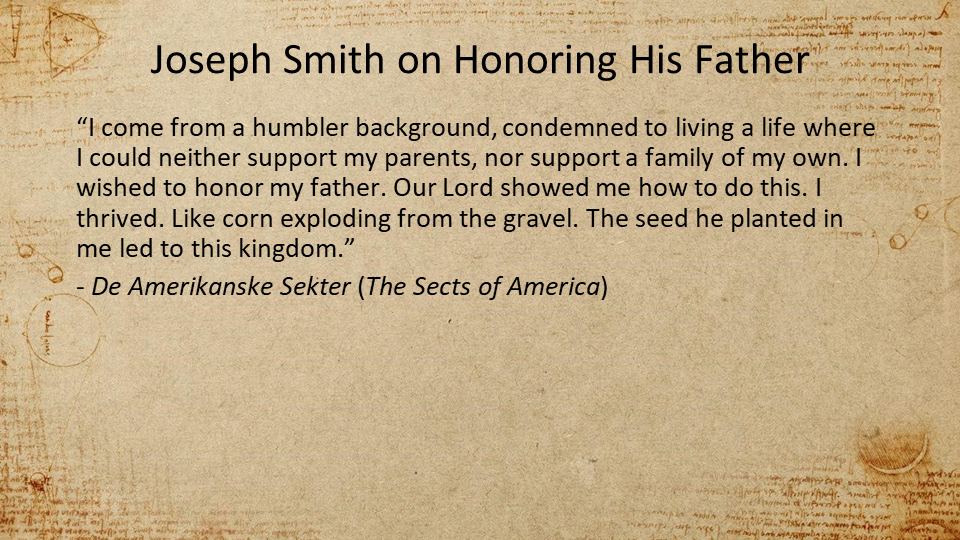
I actually have a source (there’s a complex history to the source, which I can lay out maybe more in publication since my time is flying by like crazy) Joseph Smith talked to someone from Denmark, who visited Nauvoo in 1844. And he (Joseph) was talking about how as a young man, he was condemned to living a life where “I could neither support my parents nor support a family of my own. I wished to honor my father. Our Lord showed me how to do this. I thrived. Like corn exploding from the gravel, the seed he planted in me led to this kingdom,” referring to Nauvoo. So according to this account, Joseph says one of his early motives was, “I wanted to honor my father.” If you look throughout the man’s life, he wants to honor his father. He wants to save his father. He wants to save ‘the Fathers:’ baptism for the dead, work for the dead.
Joseph Loved and Served his Family
In Nauvoo, Joseph’s journal shows him caring for his mother, Lucy Mack Smith who lived with him when she was ill; it shows him caring extensively for Emma when she was ill. And there are moments when — the journal was not kept by Joseph, it was kept by his secretary, Willard Richards — Richards shows Joseph spending days and days caring for Emma when she’s sick. And Richards talks about how concerned Joseph appears to be over Emma’s health.
Another entry, perhaps my favorite in all of Joseph’s journals: “I spent the day sliding on the ice with my son, Alexander.” This man was the mayor, the city councilor, the president of the church, the Chancellor of the University, ran a store — all these things, and he spends a day to slide on the Mississippi river ice with his child? This man loved his family.
Joseph Smith’s Visions
Another thing I started to notice was that even though at the time I thought Joseph Smith was making up his visions, I started to see that he actually couldn’t have been making them up. He wasn’t making them up retrospectively if he was making them up.
I can’t go into details here, but I actually presented several years ago here about the First Vision in the context of the Smith family in the early 1820s, and showed that the First Vision doesn’t fit the context of 1830s, so he’s not making it up then. It fits closely with the context of the 1820s. I can show the same thing with the John the Baptist experience, even though some people tried to date that to the mid-1830s.
In fact, Dan Vogel claims that Joseph Smith made up the first vision and the John the Baptist vision during a crisis of authority in Kirtland in the mid-1830s, to shore up his authority. But note that during that same time period, Joseph’s journal shows that in the Kirtland Temple, he and Oliver see Moses, Elias, Elijah, and Christ. And even though there’s a contemporaneous entry in the journal showing that this happened, Joseph never talks about it. If Joseph were making up his visions in order to shore up his authority and convince other people, wouldn’t it help to tell them to other people?
Right, like, instead of Joseph, in the 1830s like Vogel saying, telling people past visions that didn’t really happen, in fact that were present visions that did happen, that he doesn’t tell people. It’s not that the Kirtland Temple dedication was a flop: It’s that that argument against him having those visions was a flop. So, I started to wonder, if Joseph Smith is making up his visions, why is he only making them up at the time they’re supposed to be occurring, and not retrospectively? It didn’t make sense to me. It called out for explanation, and I didn’t have a good explanation.
Joseph’s Family Believed Him
Another point is that Joseph Smith’s family believed him. Those who have children can attest that parents know if their children are inclined to lie. I remember many years ago, someone that I knew was concerned her young daughter was telling a lot of ‘stories’ – fibbing. And someone else, trying to comfort her and put a positive spin on it, saying, “Well, that just shows she is creative.” She is creative — and she’s serving her third term in the state prison.
Parents have an advantage over children in that parents have been children before, but children have never been parents. And so, their lives are frequently transparent. And yet, it isn’t just that Joseph Smith’s family believe him, it’s how much they believe him, right? Alvin, on his deathbed, is telling Joseph to make sure he moves forward and gets the plates. Hyrum — and people often forget, Hyrum didn’t have to go to Carthage. Hyrum was not on trial. He just went to help Joseph. And there’s evidence he goes there knowing he may die. And yet, this is how much he believes.
Joseph’s Intrinsic Interest in Religion
Another thing that I started to say was that Lucy Mack Smith in her memoir talks about a religious discussion that the Smith family had one evening. And she says that Joseph paid particular attention to the discussion, as he always had with anything of a religious nature. If you, as a child, are always asking about science, nobody says, ‘Hey, I think that guy never had a real interest in science. He just wanted to grow up and be a con man who used science.’ That doesn’t make sense, right? Joseph just so clearly has an intrinsic interest in religion, not just an extrinsic interest later on in using religion to get things that he wants.
Profundities in the Book of Mormon
There are deep profundities in the Book of Mormon that are difficult to explain with a religiously insincere Joseph Smith. In fact, there are complexities in the Book of Mormon that people are picking out now, all the time — new complexities that have never been seen before. Isn’t this overkill? I mean, if you’re going to try to put things in the book, just to sell it to other people, why would you put things in there that take hundreds of years to ferret out?
In the Book of Mormon, we have powerful spiritual teachings and even spiritual practices. For example, there’s a historical Christian contemplative practice — powerful practice — of constant prayer, known generally as ‘the practice of the presence of God.’ In the 1600s there was this Catholic monk, Brother Lawrence of the Resurrection, who wrote a book, The Practice Of The Presence Of God, that talks about this deep spiritual life he had of holding a sort of constant conversation with God in his mind, and doing these what he calls little ‘interior glances toward God,’ where he’s sort of ‘looking toward God’ throughout his day. Well, you mean like Alma 37:36-37 where it says, ‘Let all thy thoughts be directed unto the Lord,’ and ‘counsel with the Lord in all thy doings and he shall direct thee for good.’ Or D&C 6:36 “Look unto me in every thought, doubt not fear not.” Whoever the author or authors are of these texts, they have a deep familiarity with the real lived spiritual life.
My friend Maxine Hanks offered a thought on this. Maxine was, for years, an Ex communicant, she was one of the September 6 Ex communicants 30 years ago, in September of 1993. And while Maxine was out of the church, in 2003, and very much not a believer in the restoration, she wrote this in the book, Latter-day Dissent.
“The Book of Mormon is valuable for its spiritual messages and resonance, sublime teachings or moments that speak to the soul and move the reader into holy experience, spiritual experiences captured and recorded in the text then reproduced in the reader recreated anew that scripture.”
Maxine’s point, which she later explained to me in more detail, was that spiritual experience only comes out of a book in one’s encounter with it, if spiritual experience went into the book from its author or authors at its creation; suggesting that the Book of Mormon’s spiritual power arises from the genuine spirituality with which it was created.
Which Model Fits Best?
With all these things, we can ask which model fits best. Which model best explains each of these things? You may not all come up with the same answer. But I think many of you will come up with this answer.
Joseph and the Practice of Polygamy
What is seen as the most obvious ‘tell’ among critics that Joseph Smith is a fraud? I just spoke to someone the other day, who told me that as soon as he found out that Joseph Smith practiced polygamy, he stopped believing. This is seen as something really obvious, you know: the attitude is, “Why else would a religious leader introduce polygamy other than that he’s a fraud, and just wants lots of sex?”
Most of you know about my work for Brian Hales, where Brian wanted me to gather every source had ever been cited and anything that has ever been written on Joseph Smith and polygamy, and then see what else could be found. That involved going to all the different repositories in Utah, getting things from the Huntington Library in California, going through the D. Michael Quinn papers at Yale a couple times, and so on. At the time I was doing that work for Brian, I thought Joseph Smith was an opportunist. So, I was looking at all those sources through the lens of “what was in it for him?” — assuming this is about sex, right?
I mentioned earlier the importance of getting events in the right order. I’m going to walk you through why that’s important in the case of understanding the motives behind Joseph Smith’s polygamy – and we can get real solid glimpses into the motives behind Joseph Smith’s polygamy.
Prototypes as Cultural Keys
One thing I would suggest is that the prototype instance of any sort of social institution tells you something about what that institution is about: what’s the motive behind it, what is it for, what’s its function. And so, it has long been believed — ever since 1886 — that Mormon polygamy, Nauvoo polygamy, begins in a certain way.
How Nauvoo Polygamy Begins
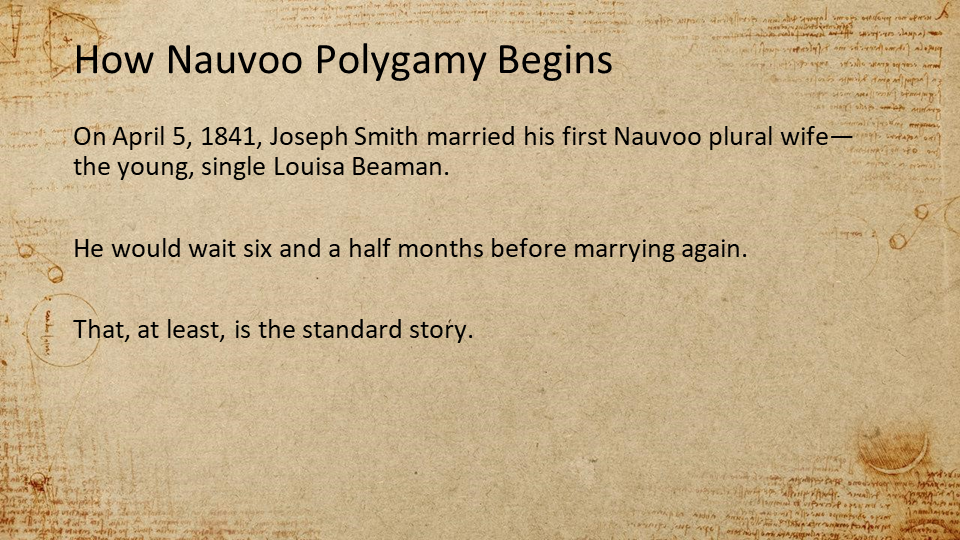
On April 5, 1841, Joseph Smith married his first Nauvoo plural wife, the young single Louisa Beaman. He would wait another six and a half months before marrying again.
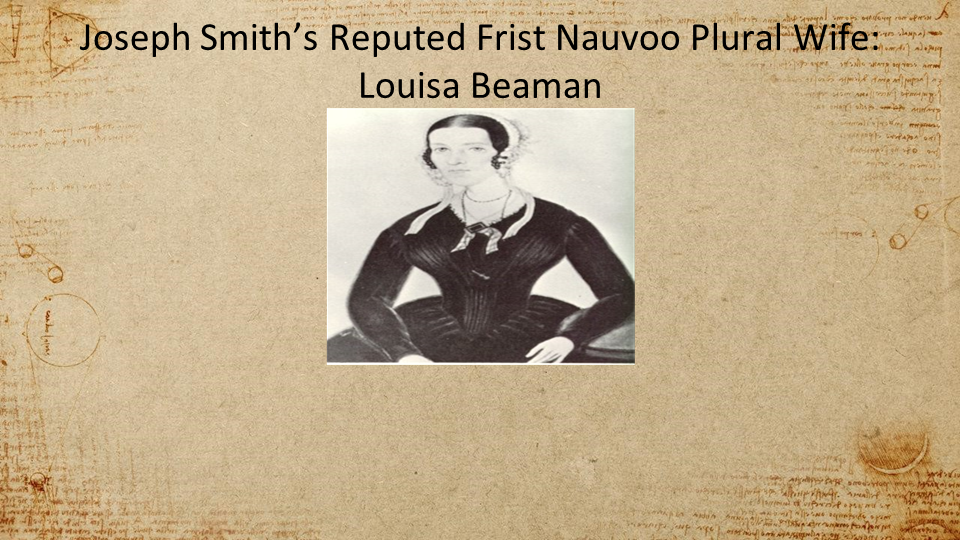
That at least is the standard story — this is Joseph’s reputed first Nauvoo wife. But when you look at the story, there are anomalies.
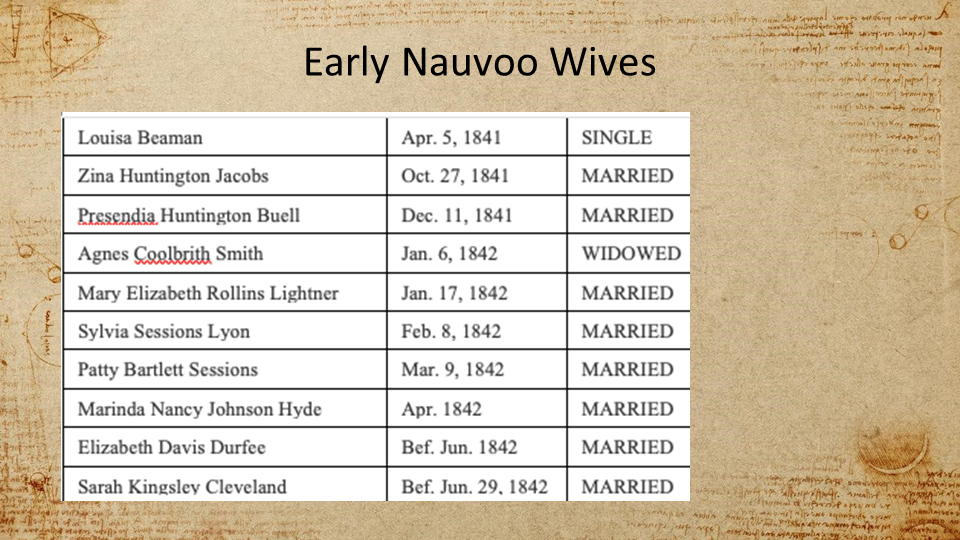
One of the things you’ll notice here is – ‘one of these things is not like the others.’ There are a number of women who married Joseph early on when he’s starting polygamy at Nauvoo. And all these women have previously married except for one. And that’s Louisa Beaman, the one who was supposedly first.
Louisa Beaman as an Outlier
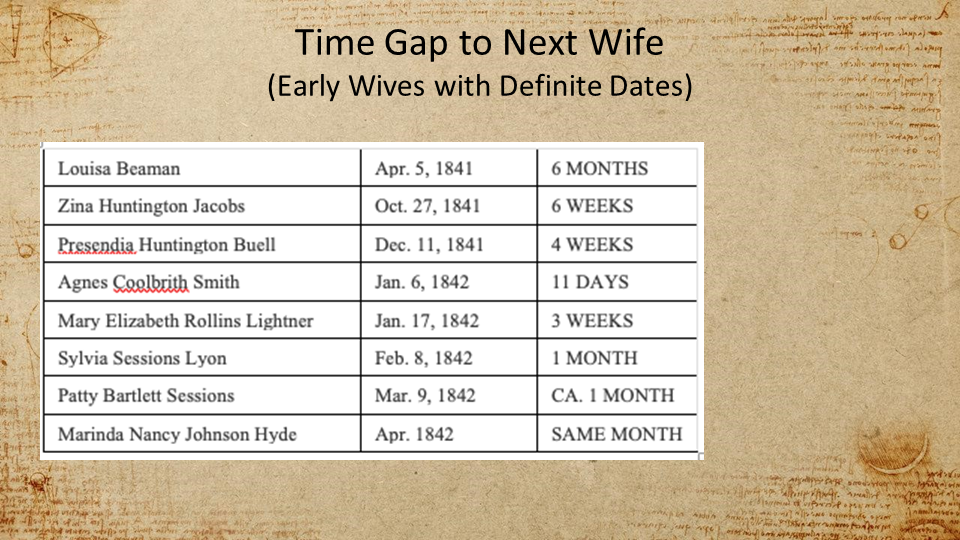
Look at the time gap between these wives. It turns out that the early ones that we have definitive dates, it’s just a matter of weeks, usually, or maybe a month, between marriages. But between the one that’s supposed to be the first one, and the second one, there’s a gap of six and a half months. So that one is an outlier in two ways: Louisa Beaman was never married, and there’s this unexpectedly large gap there.
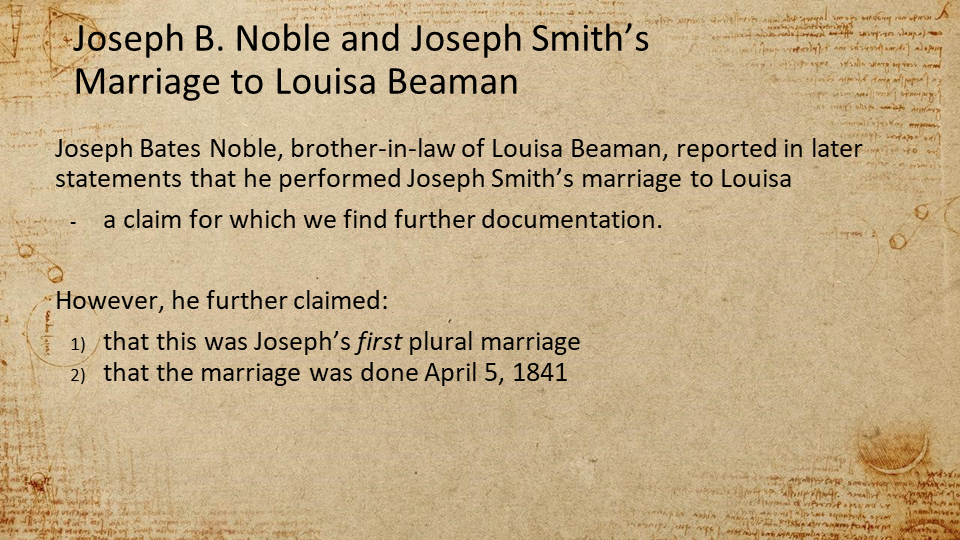
So, why is it that we put things in this order? Since it’s sort of anomalous, we want to ask the question, “Why do we believe this in the first place? Why do we put Louisa Beaman first?”
Now the person who performed the marriage, Joseph B. Noble (who was a brother-in-law of Louisa) reported in later statements that he performed Joseph Smith’s marriage to her, a claim for which we find further documentation. There is no reason to doubt he performed the marriage. However, he further claimed that this was Joseph’s first plural marriage, which is questionable, and that the marriage was done April 5, 1841 — which we will also question. (By the way, he also claimed to have the first child born in polygamy, and that’s demonstrably not the case; that was Heber C. Kimball.)
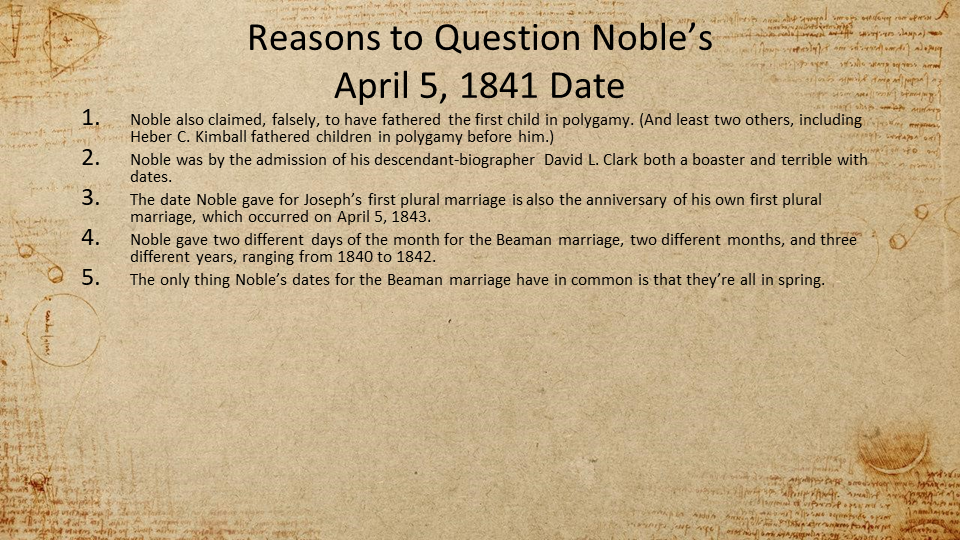
Reasons to Question Noble’s Dating of Events
There are several reasons to question Noble’s dating. Noble was, by the admission of his descendant biographer[ii], terrible with dates. So, there you go, guys, this is the guy we’re relying on for the chronology of Nauvoo polygamy, and what do we know about him? That he’s terrible with dates. We also know that (just to confirm that he’s terrible with dates) his own first plural marriage happened to be on the same day that he said Joseph’s was, two years later — which would be a strange coincidence.
Noble actually gives a variety of dates. The reason April 5, 1841 became the popular date is because that happened to be the date in the affidavit that Andrew Jenson had. But there are other affidavits, there are other statements, and they give two different days of the month, two different months (April and May), and three different years ranging from 1840 to 1842. In fact, the only thing these dates have in common is they are all in the spring.
The Crucial Detail
That detail — that they’re in the spring — is the card that brings the whole house down. In the Temple Lot Case, Noble was asked to testify, and he was all over the map and the dates that he gave for the marriage, but then they asked him, “Where did it occur? I know you don’t remember when it occurred, but how about where did it occur?” And he says, “it was in Nauvoo,” and the person says, “At whose house?” and he says, “At mine.” But research by Gary Bergera indicates that Noble “moved his family, including presumably Louisa, to Nauvoo sometime after September 1841.” I also found that the descendant biographer found the same thing and says the same thing in the biography:
“Later in 1841 [after September], the Noble family moved to Nauvoo and lived in a temporary log house prior to the construction of their permanent home.”[iii]
He says Noble moved his family, including presumably Louisa, to Nauvoo sometime after September 1841. And the descendant biographer says it was after that point that he built his house.
If Joseph was married to Louisa Beamann at the Noble’s house at Nauvoo, and the Noble family didn’t move to Nauvoo till after September 1841, and the marriage occurred in the spring, then the spring in which it occurred could not have been the spring of 1841. So, we move that one back to 1842 and that changes the order of these early marriages.
Introducing a Thought Experiment
I want you to do a thought experiment for just a second. Think about Joseph Smith, seeing his first Nauvoo plural wife before he marries her and realizing he is going to marry her, anticipating marrying her — just for a second, picture him looking at this woman thinking “I’m going to marry her.” I’m going to come back to that.
Correcting the Order of Joseph’s Plural Wives
Here’s the traditional order of Joseph Smith’s Nauvoo wives with Louisa Beeman first.
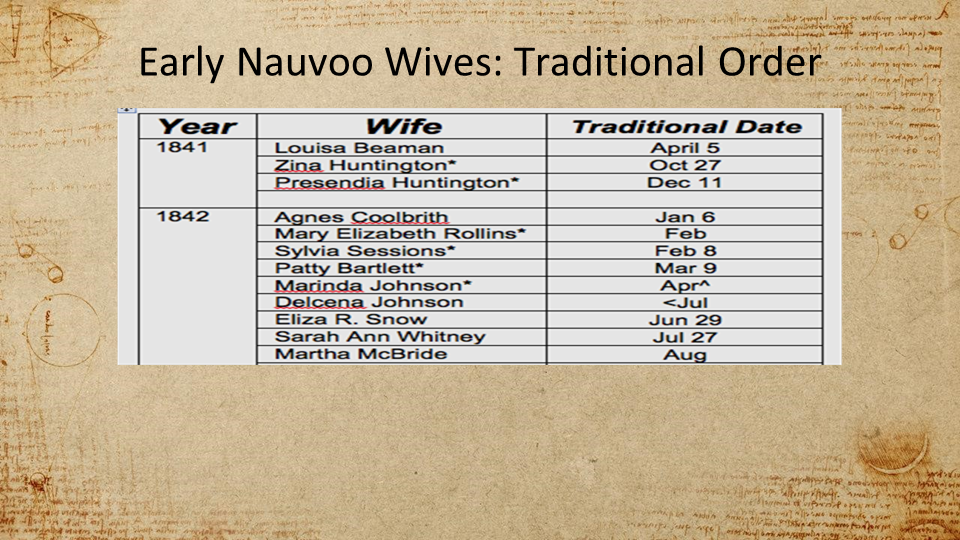
Here’s the corrected order when we move Louisa Beamann down to the spring of 1842. The one who was second on the list is now actually first.
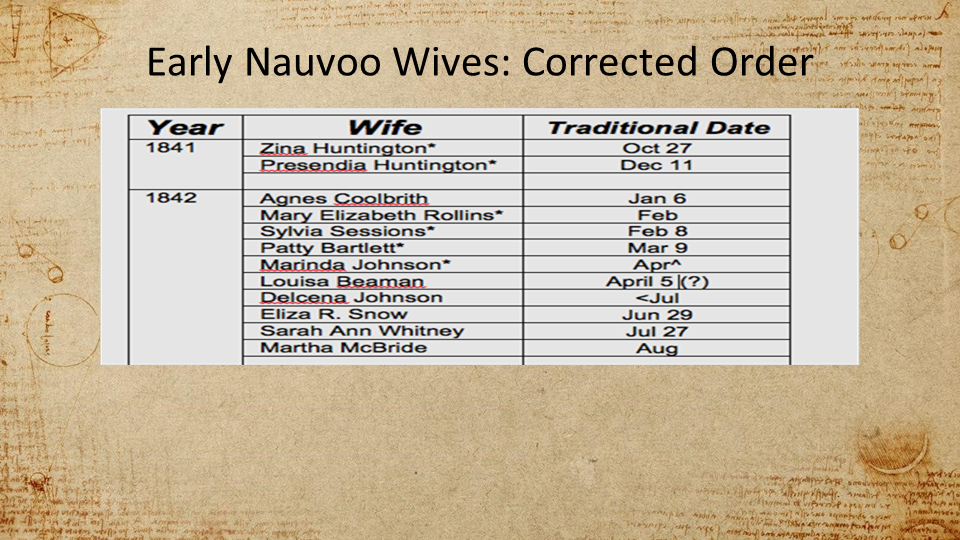
This takes care of the anomalies that we saw earlier. Instead of him starting out with single (women), then women who’re already married, and then going back to marrying single women; he starts out just with marrying women who are already married. And then he shifts later to marry just single women, and Louisa is one of those later ones. Also, you’ll see, there are no big gaps anymore between the marriage dates. So, it eliminates the gaps and the other anomaly:
Joseph’s first Nauvoo plural marriage was thus to Zina Huntington Jacobs, eliminating the anomalies that emerged when the marriage to Louisa Beaman was placed first.
Resolving the first anomaly, there were no large gaps between Joseph’s marriages to his early Nauvoo wives.
As I mentioned, Joseph’s not the first to marry Zina Huntington; she has a legal husband Henry Jacobs who had already married her, making this first Nauvoo plural marriage “polyandrous.” So, we’ve got a clear trend line now.
Back to the Thought Experiment
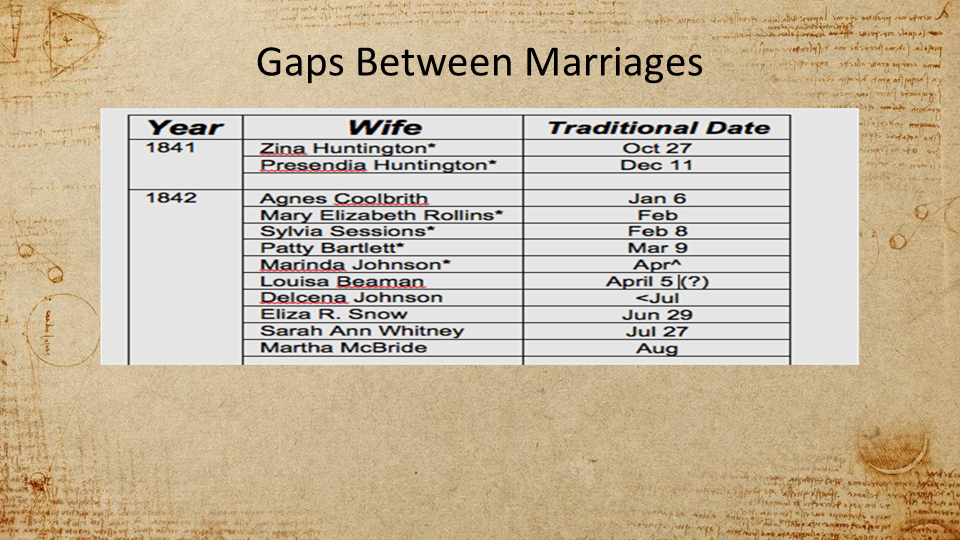
Okay, so now back to our thought experiment. Can you picture Joseph Smith looking at his first Nauvoo plural wife before he marries her anticipating being married?
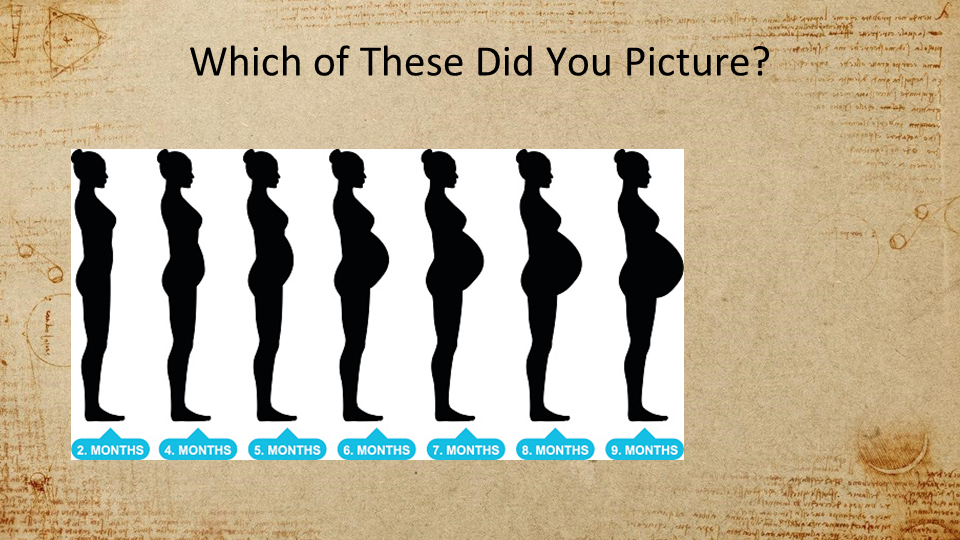
Which of these best matches the image that you had in your mind? Here’s why I ask — because the third from your right would be the correct image. Seven months pregnant.
Zebulon Jacobs, Zina’s first child, was born January 2, 1842. When Joseph married Zina, she was seven months pregnant. Now by the way, the descendants of that child have been DNA tested: they are not descended from Joseph. The child was actually the legal husband, Henry Jacobs’, child. So, while it’s not necessarily clear for us immediately what Joseph’s motive was, it becomes clear maybe what Joseph’s primary motive wasn’t — sex.
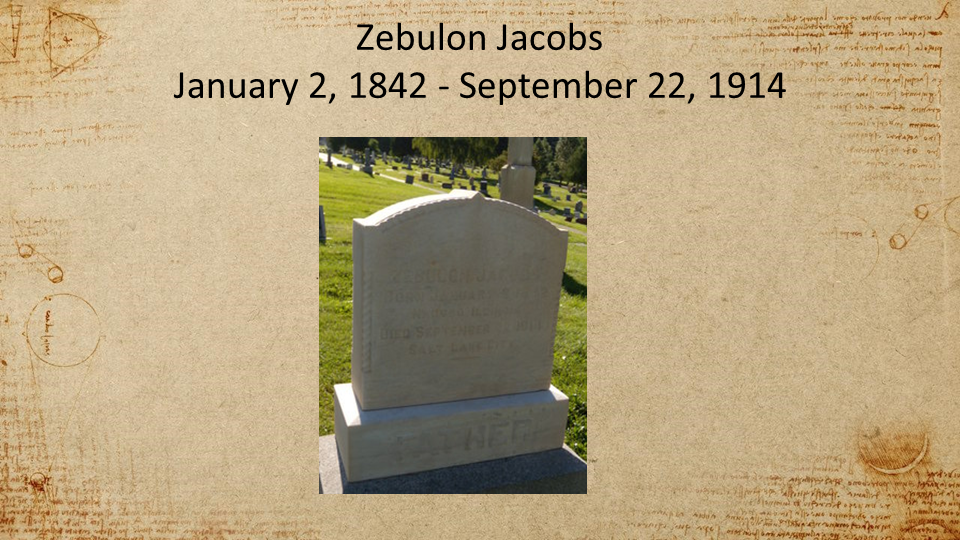
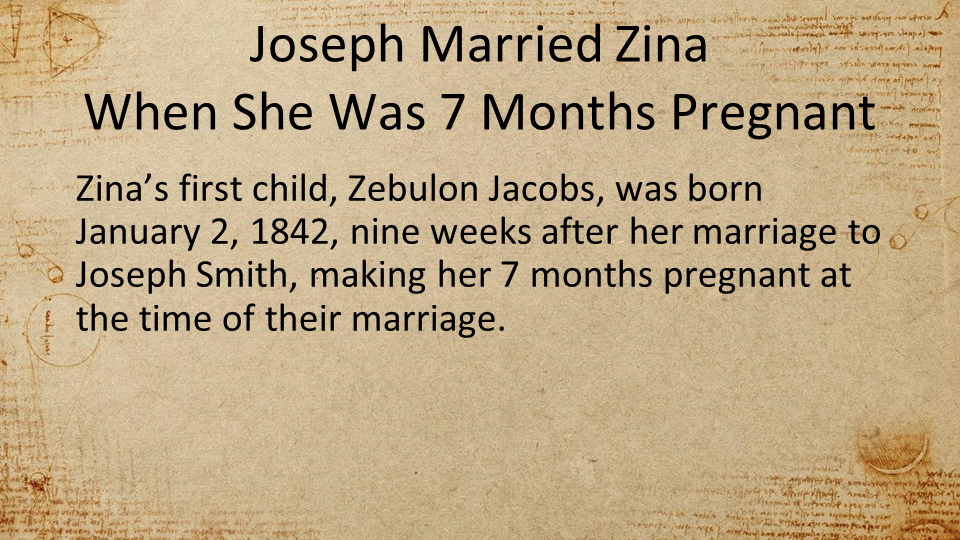
Not only would Zina have been awkwardly pregnant at the time of the marriage, but medical advice of the day also advised against sex during pregnancy, warning that it could be harmful to the unborn child. So, if all of this was Joseph Smith’s way of getting women — “the hot babes” — for quick sex, immediate sex — somebody needed to give the guy lessons because he was doing it wrong. This is not the way to do that.
In other words, when you look at the different models, this one doesn’t fit the conclusion people say is obvious: he practiced polygamy, so he was fraud. Have you looked at how he practiced polygamy — this this is our prototype case then, of Nauvoo polygamy. This tells us something about what Nauvoo polygamy is about.
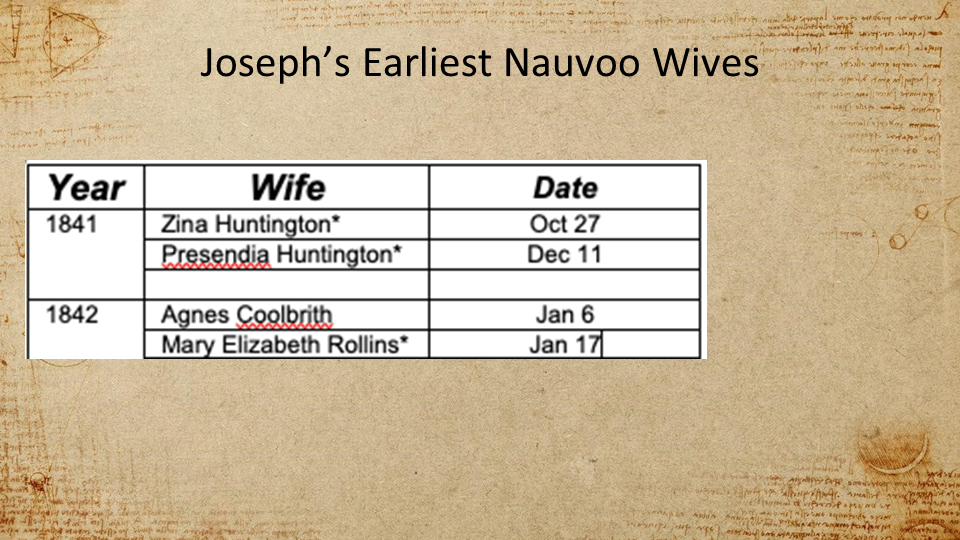
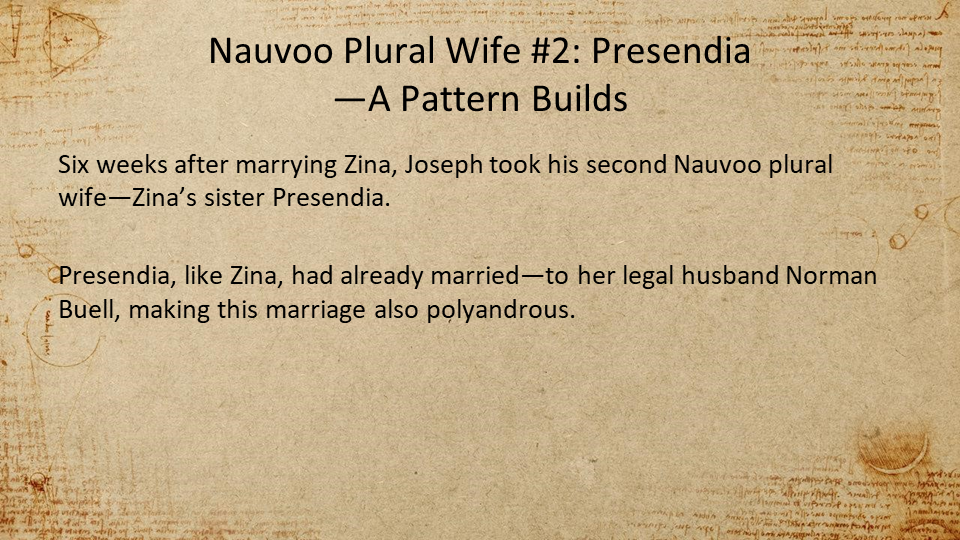
Joseph’s second Nauvoo wife is Zina’s sister; that one’s a little more complicated. It actually appears that she was pregnant: the exact date of a child’s birth was not recorded because the child was born and immediately died.
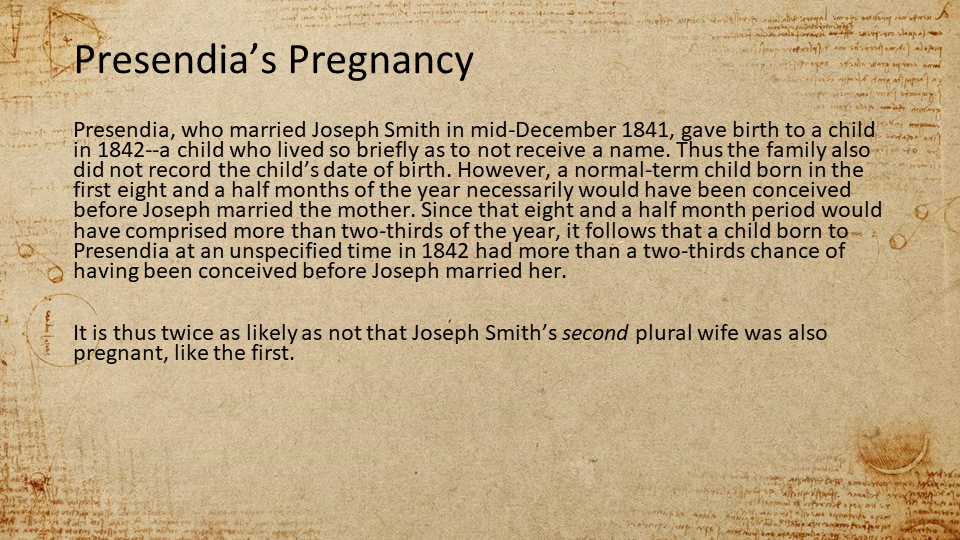
The third wife that he marries, Agnes Coolbrith, was not pregnant; but the fourth wife that he marries, Mary Elizabeth Rollins Lightner, was seven or eight months pregnant.
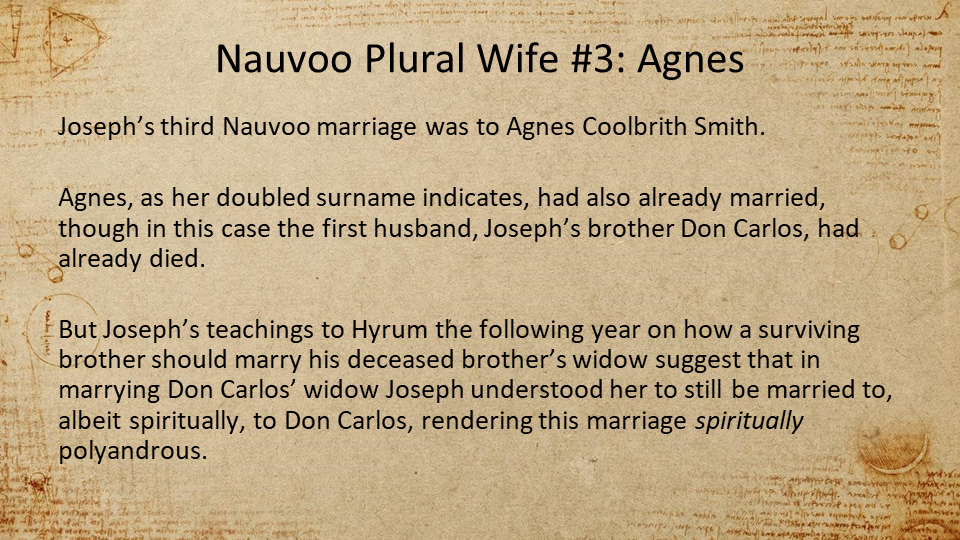
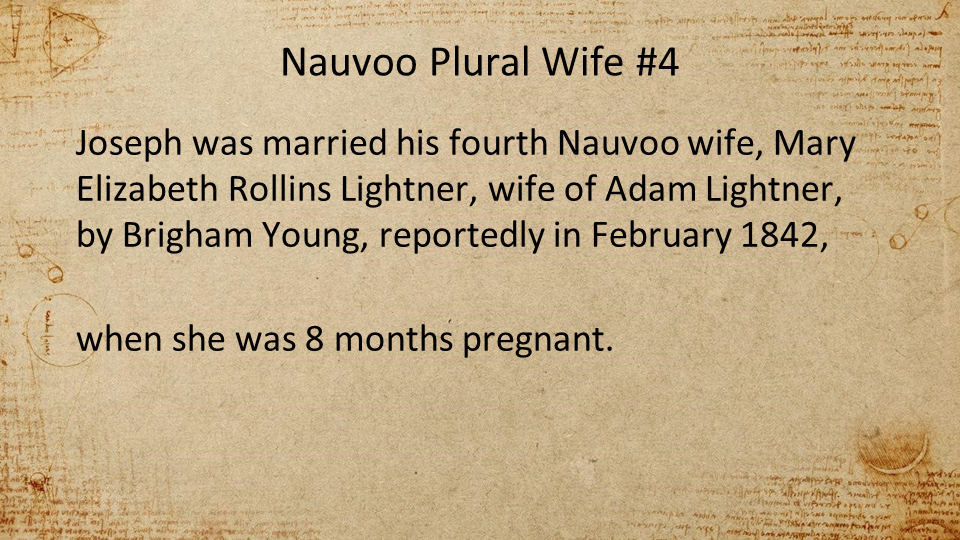
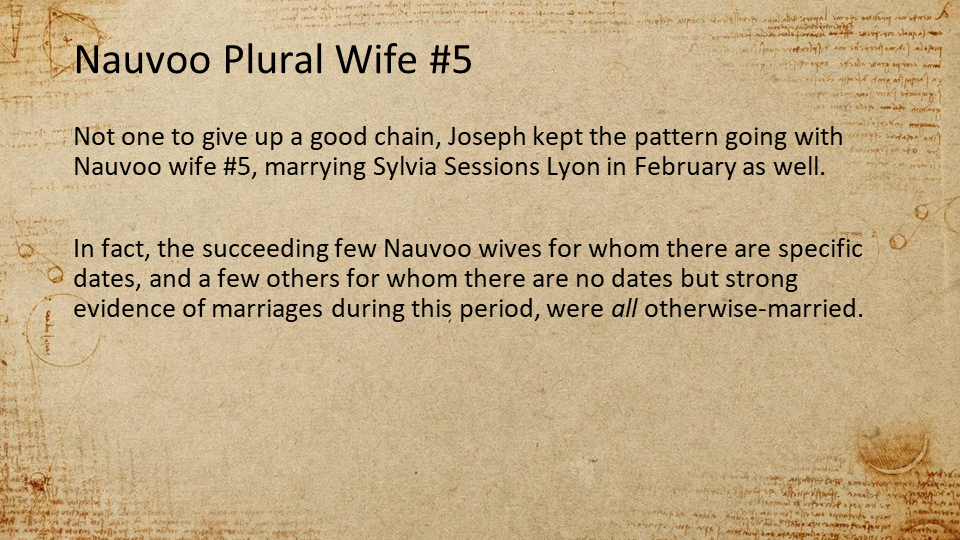
So, there’s a pattern here. It’s as if he wants to marry women who are as close as possible to giving birth. Why?
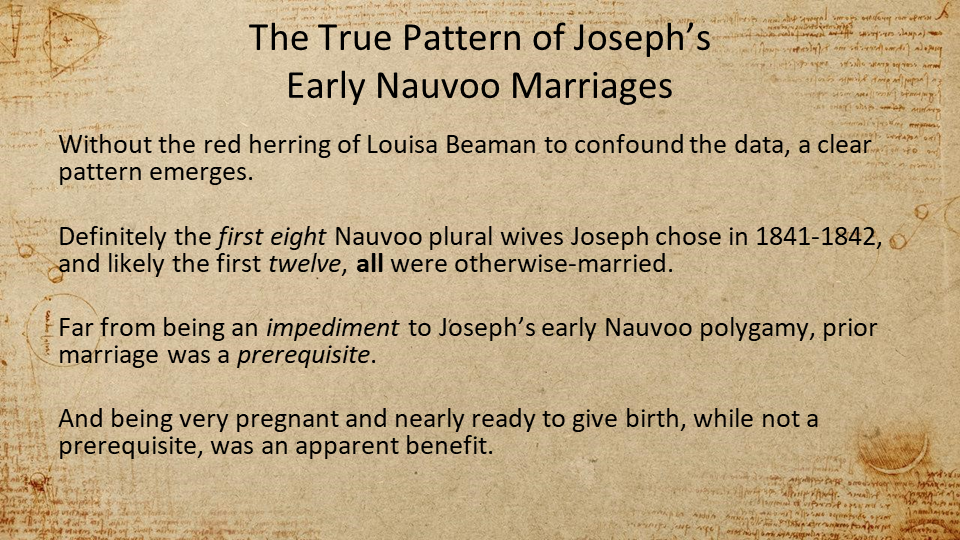
Why Marry Pregnant Women?
A sensible reason to infer from this — at least as a strong possibility — is that he wants to have children born soon into these marriages. He effectively wants to adopt the children. Revelation has promised him lineal priesthood and lineal blessings will be passed on to his children. So, you know, of course, he could just have more biological children in his polygamy, so why is he trying to adopt? This is not the only possible reason, but certainly one possibility would be that he’s actually trying to live polygamy to raise up seed through polygamy without having to have sex with women other than Emma. Adopting these women’s children would certainly be one way to do this.
Although it’s seen as obvious that Joseph institutes Nauvoo polygamy in order to have sex with many women, his behavior at the outset refutes this and would be better explained by an attempt to avoid the very sex that was the supposed motive for the polygamy. Know, also, that when I was talking earlier about family believing him: the people who say it’s so obvious that Joseph was a fraud because of polygamy. They often are very defensive of Emma (which I think is good). But they seem not to recognize that the supposed greatest victim of what he’s done – the person impacted most by this – believes in him. She rejects polygamy, but she never stops believing in her husband’s sincerity, or that he’s a prophet. So again, what model does all this fit?
The Angel with the Drawn Sword
Picture this. I’ve laid this out to a few people here. But there’s something else really startling that emerges once we put Zina in her position as the first of Joseph’s Nauvoo wives. And that is, Zina says that when Joseph proposed to her, he sent the proposal through her brother Dimmick, and he says to Dimmick, ‘Tell Zina that I put it off and put it off until an angel came with a drawn sword and told me I had to move ahead.’ Joseph’s making it clear that he had delayed and delayed up until the angel with the drawn sword, but once the angel with the drawn sword comes, he’s not delaying anymore. This is significant because it gives us a chronological clue about when the angel with a drawn sword experience occurred. And it occurred shortly before the proposal to Zina.
Zina, in talking about the proposal, makes it clear she doesn’t accept the proposal immediately. She thinks about it. But she also doesn’t make it sound like there’s a long delay after that. Their marriage was on October 27, 1841. So, I started looking for events that occurred in Joseph Smith’s life and the restoration of the church just before that – if would there be anything that might have to do with the angel with a drawn sword.
Something that I found in the history of the church was a letter written by one of the apostles on October 19, 1841 (this is eight days before Joseph and Zina get married) and he says he looked up in the sky, and he saw a glittering sword. And he says what is more, a hand came and grasped the hilt of that sword. If you’re going to draw a sword, when you do, you grab the sword by the hilt and draw it out. Now, the person who said this was actually Orson Hyde.
Orson Hyde at that time was on a ship, taking passage to Beirut, I think it was. He’d gone to dedicate Jerusalem — he was on the other side of the world. But he sees a sword in the sky and a hand grabbing the hilt. And I was dumbfounded by this, it seemed nuts. I looked and it turns out that there was a meteor shower going on at the time. There were others on the boat with Orson Hyde. They were Arabs and they cried out at the exact moment that he saw the sword and the hand. They cried out “Allah! Allah! Allah!” — so they saw this too. It wasn’t a vision; it was something actually in the sky.
It wouldn’t have been visible at the exact same moment in Nauvoo, but the same meteor shower would (at different hours) have been visible in Nauvoo. And this goes along so remarkably with Joseph describing at this time seeing an angel with a drawn sword. And I thought about when, during the Great meteor shower of 1833, Joseph wrote in his journal about it — how someone called him to “rise and behold the signs in the heavens; I arose and to my great joy, Behold, the stars falling from heaven, like a shower of hailstones, a literal fulfillment of the Word of God, as according to the Holy Scripture is a sure sign that the coming of Christ is close at hand.”
Joseph and Radical Providence
So, we know that Joseph tends to look for signs in nature, including in the heavens. And one of the things that I’ve seen over and over (and most of the examples of this are so complex that it would take me another hour to lay out one or two) is that Joseph Smith was a believer in what I would call “radical providence.”
You know D&C 59:21 where it says, ‘now against none is his wrath kindled save those who keep not his commandments, and acknowledge his hand in all things.’ Joseph sees God’s hand in all things. So as part of his process of discerning the will of God, he looks for signs. And this I can see clearly: when you line up the historical events in the right order, and then you look, you can actually watch in real time — as Joseph encounters something in nature or something in his life, that seems to be a sort of divine sign pointing in a certain direction. And he immediately makes a course correction going in that direction.
Joseph Smith: a Model of Sincerity
Let’s say he’s an opportunist. An opportunist cares what he wants. He doesn’t care what the universe wants him to do. He’s not looking for signs of what God wants him to do — he only cares what he wants. Over and over, that’s not what I see with Joseph Smith. Clearly on so many levels, Joseph Smith is sincere and the larger pattern — where we map out the pattern of tens of thousands of actions and speech events in his life — the more clear it becomes to me that Joseph Smith was religiously sincere. He believes in what he’s teaching. He believes that God has called him as a prophet and is speaking through him.
Because the Lord commanded the early saints that detailed records of the restoration be kept, millions can and will know brother Joseph again. And I would argue that in many ways, we might know him better than they did the first time. Thank you.
Endnotes
[i] biography that idealizes its subject.
[ii] David L. Clark
[iii] Joseph Bates Noble: Polygamy and the Temple Lot Case, by Joseph B. Noble descendant, professor David L. Clark (p. 66)
